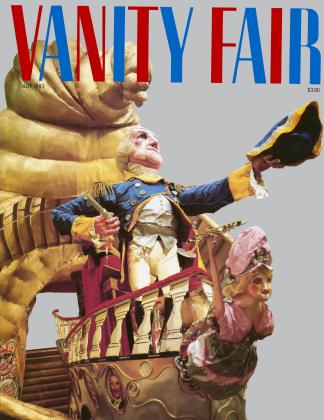Sign In to Your Account
Subscribers have complete access to the archive.
Sign In Not a Subscriber?Join NowAft
JOSEPH STELLA (Hirshhorn Museum and Sculpture Garden, Washington, D.C., through July 17). Like several other American painters who went modernist around the time of the 1913 Armory Show, Joseph Stella, who was born in Italy in 1877 and died in New York in 1946, was immensely gifted and had a career blighted by the inhospitality of the culture that surrounded him. He is thrilling or depressing, depending on whether one considers the high points or the pattern of waste and incoherence revealed by the work as a whole. His reputation resurges now and then, only to slip back into semineglect.
Stella seems due for another resurgence. A new generation has come along—paint-intoxicated and unfazed by stylistic eclecticism—and this audience is made to order for the futuristic rhapsodist of the Brooklyn Bridge and Coney Island. (One even notes affinities to another Italian-born painter in New York, the present phenom Sandro Chia.)
This small show, which curator Judith Zilczer has drawn from the Hirshhorn’s permanent collection, is light on masterpieces and heavy on Stella’s often gawky eccentricities. The works range from an early crepuscular view of an Italian church to a weird late portrait of his mistress as a Renaissance lady in a jukeboxcolored landscape. But there are some terrific paintings, including two studies for Battle of Lights, Coney Island that all but shiver with excitement, and a gorgeous landscape, painted on glass, that is poignant with possibilities never fulfilled. And even Stella’s least efforts, given today’s taste, communicate an audacity that is pure elixir.
PETER SCHJELDAHL
GEORGES BRAQUE: THE LATE PAINTINGS 1940-63 (Museum of Fine Arts, Houston, July 15-September 11). There are two Georges Braques. First there is the towering aesthetic revolutionary whom recent scholarship has established as first among equals, along with Picasso, in the invention of cubism and collage. Then there is the later, post-World War I Braque, the quiet maker of quiet pictures notable for their elegance, painterly cuisine, and passionate moderation—peculiarly “French” virtues which, like country wines, tend not to travel very well.
This show is devoted to the second Braque, and if it does not alter the balance—and it shouldn’t—it does give us a rare chance to savor the peculiar strengths of the late work. Foremost among these is the metaphorical charge with which Braque invested the sheer substance of paint; encrusted surfaces convey the sensation of a world in which space, at the boundaries of objects, pauses only to change color. With the blunt hand of a rural craftsman and the rationality of a Chardin, Braque expressed his utter contentment with this world, as if he lived in a state of pleasant surprise at the rough luxury of simply existing.
Still, there remains something stolid and unimaginative about it all—suggestive, perhaps, of a happiness so remote from contemporary life that it might belong in some museum of emotions. The second Braque’s authority and limitation come down to the same thing: he suited himself. The first Braque suited a century as well. P.S.
SCOTT BURTON CHAIRS (Walker Art Center, Minneapolis, July 10-August 28). In the early 1970s, Scott Burton—an art critic, performance artist, and furniture aficionado—put some chairs outdoors and had them photographed. He put other chairs in a gallery, arranging them in an intensely theatrical tableau. Then he took a homely old chair and had it cast in bronze. Thus began one of the most remarkable aesthetic adventures of recent times, a safari into the twilight zone between art and design.
The chairs and tables Burton has created since the mid-’70s function as wordless scholarly treatises on style, from the high modernism of Breuer and Mies to the obsolete vernacular of wooden Adirondack lawn furniture—with allusions, too, to constructivism, futurism, minimalism, and other art movements. Vastly entertaining by virtue of their witty exaggerations and elements of fantasy (most apparent in the chairs carved from boulders), these furniture pieces have, at the same time, a tough sculptural presence and the edge of Burton’s serious intention: to reform our idea of amenity in a way that combines the best of art theory and furniture design.
Also you can sit in them. P.S.
 View Full Issue
View Full Issue












Subscribers have complete access to the archive.
Sign In Not a Subscriber?Join Now